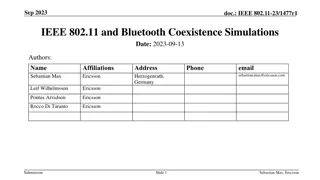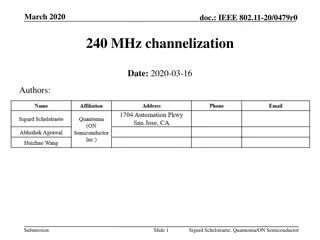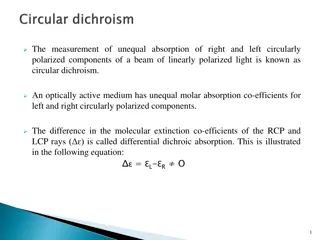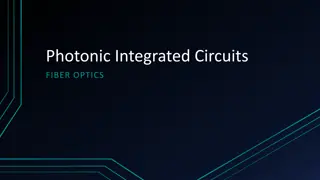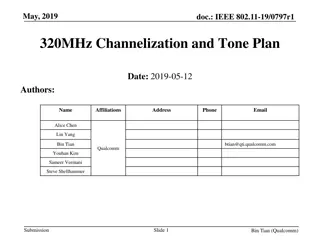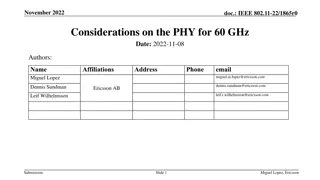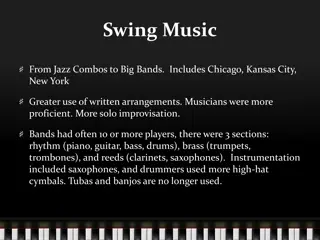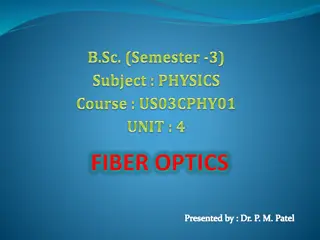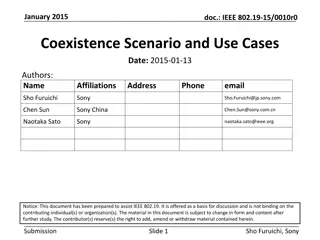Channelization to Include Optical Bands in IEEE 802.11 Standards
This document discusses the proposal to incorporate optical bands into the channelization framework of the IEEE 802.11 standard. It aims to align the channelization approach for integrated LC with that of mm-wave technology in the IMMW scope. The contribution highlights recent works, emphasizing the importance of reusing existing standards to expand the scope effectively. The document also explores the feasibility of optical bandwidth utilization in different applications.
Download Presentation

Please find below an Image/Link to download the presentation.
The content on the website is provided AS IS for your information and personal use only. It may not be sold, licensed, or shared on other websites without obtaining consent from the author. Download presentation by click this link. If you encounter any issues during the download, it is possible that the publisher has removed the file from their server.
E N D
Presentation Transcript
January 2024 doc.: IEEE 802.11-24/0062r0 Channelization to include Optical Bands Date: 2024-01-15 Authors: Name Affiliations Address Phone email Volker Jungnickel volker.jungnickel@hhi.fraunhofer.de Fraunhofer HHI Lennert Bober Matthias Wendt Signify Andreas Bluschke Maximilian Riegel Self Self Submission Slide 1 Volker Jungnickel, Fraunhofer HHI
January 2024 doc.: IEEE 802.11-24/0062r0 Abstract This contribution considers channelization to include optical bands into the IMMW scope. It is proposed to harmonize the channelization used for integrated LC with the one to be defined for mm-wave in IMMW. Submission Slide 2 Volker Jungnickel, Fraunhofer HHI
January 2024 doc.: IEEE 802.11-24/0062r0 Previous work and this contribution Recent contributions in IMMW SG show significant interest in use of higher bands [1-4] proposed to reuse existing Sub-7GHz baseband waveforms [2] discussed ideas about channelization for mm-wave [5, 6] proposed a limited scope in general [7] discussed beacon issues [8] proposed to include optical bands [9, 10] provide background on 11bb in optical bands this approach can only work if parts of the standard are reused Channelization is one critical issue definitions should be similar to mm-wave Source: Extend IMMW scope to include optical bands, 11-23/2016r2 [8] Submission Slide 3 Volker Jungnickel, Fraunhofer HHI
January 2024 doc.: IEEE 802.11-24/0062r0 11bb already reuses 5 or 6 GHz baseband [9, 10] RF up-conversion Idea was to reuse existing chipsets RF frontends up-convert BB signals to sub-7 GHz LC frontend up-converts baseband onto LC IF e.g. lowest LC IF is 26 MHz for 20 MHz channel 11bb enables same data rates, same interfaces, same capabilities like 11n, 11ac, 11ax PHY+MAC Freq Freq 0 0 5 or 6 GHz LC IF up-conversion 20 MHz Freq Freq 0 0 26 MHz Submission Slide 4 Volker Jungnickel, Fraunhofer HHI
January 2024 doc.: IEEE 802.11-24/0062r0 11bb Channelization [9, 10] 11bb uses block up/down-conversion, similar to satellite radios subset of consecutive channels is taken from 5 GHz or 6 GHz bands Optical frontends have limited bandwidth LEDs: ~ 100 MHz, VCSEL arrays: substantially more BW Submission Slide 5 Volker Jungnickel, Fraunhofer HHI
January 2024 doc.: IEEE 802.11-24/0062r0 What optical bandwidth is feasible? High-power LEDs: mobile applications, up to 100 MHz BW 11bb channelization is enough, 11bb channels corresponding to 5 GHz band are useful Recent research results on vertical cavity surface-emitting laser (VCSEL) arrays Small VCSEL array and OFDM higher capacity 17 Gbps with 14 mW and OFDM/bitloading [11] 1.5 GHz BW limitation due to optical RX collimated beam few cm TX coverage fixed wireless use cases High-power VCSEL arrays and OOK 4 Gbps with 350 mW and OOK [12] subarrays with parallel drivers, concept is scalable to higher power 1.5 GHz BW limitation due to optical RX several m TX coverage multiple Gbps for mobile use cases Summary: Several GHz bandwidth are possible, even with high-power VCSEL arrays. wider coverage Submission Slide 6 Volker Jungnickel, Fraunhofer HHI
January 2024 doc.: IEEE 802.11-24/0062r0 Proposed IMMW Channelization [2] 11ad/11ay channelization hardly used, spectrally very ineffective 320 MHz blocks in 11be suggest new channelization 2.56 GHz bands, each split into 1 x 2.56 GHz 2 x 1.28 GHz 4 x 640 GHz 8 x 320 MHz Submission Slide 7 Volker Jungnickel, Fraunhofer HHI
January 2024 doc.: IEEE 802.11-24/0062r0 Proposed channelization to include optical bands docs. [13, 14, 9] proposed to continue work on LC in new 802.11 projects assuming 2.56 GHz optical modulation bandwidth maybe realistic in 5 years the lowest 320 MHz super-channel overlaps with entire 11bb modulation spectrum the proposed scheme is generic, i.e., lower bandwidth (e.g. 160 MHz) are possible, likewise entire BW covered by 11bb Submission Slide 8 Volker Jungnickel, Fraunhofer HHI
January 2024 doc.: IEEE 802.11-24/0062r0 WDM to define further optical bands LEDs 11bb defines wavelength-division multiplexing [9] colorless LC TX operates in 800 nm to 1000 nm band (near IR) splitting the optical band into two sub-bands Source: https://www.vision- doctor.com/en/ir-illumination.html TX1: 800 nm to 900 nm, TX2: 900 nm to 1000 nm summation of both bands at RX: Compatibility with colorless LC TX optical spectra of LED are relatively wide Source: https://www.box-laser.com/850nm- 10mw-to-can-vcsel-laser-diode.html VCSEL remove crosstalk needs additional MIMO processing VCSELs do have much narrower optical spectra no more MIMO processing needed to isolate WDM LC TXs Source: https://en.wikipedia.org/ wiki/Interference_filter lower complexity: use a bench of optical filters denser WDM with more optical sub-bands are possible 4 optical sub-bands: TX1: 800 nm to 850 nm, TX2: 850 nm to 900 nm, TX3: 900 nm to 950 n, TX4: 950 nm to 1000 nm summation of sub-bands at RX: Compatibility with colorless and 2-optical sub-bands Submission Slide 9 Volker Jungnickel, Fraunhofer HHI
January 2024 doc.: IEEE 802.11-24/0062r0 Summary Channelization should be harmonized when including optical bands. GHz bandwidth maybe achievable using VCSEL arrays instead of LEDs. Same channelization like for IMMW should be adopted also for use in optical bands. Multiple optical bands should map onto different wavelengths using WDM. Simple multiplexing/demultiplexing of optical bands by using optical filters Submission Slide 10 Volker Jungnickel, Fraunhofer HHI
January 2024 doc.: IEEE 802.11-24/0062r0 References Integrated mmWave Design Considerations, doc. 11-23/1819r1 https://mentor.ieee.org/802.11/dcn/23/11-23-1819-01-immw-integrated-mmwave-design-considerations.pptx [1] High-Level Design Considerations of IMMW, 11-23/1878r1, https://mentor.ieee.org/802.11/dcn/23/11-23-1878-01-immw-high-level-design-considerations-of-immw.pptx [2] [3] Requirements Analysis for IMMW Use Cases, 11-23/1977r1, https://mentor.ieee.org/802.11/dcn/23/11-23-1977-01-immw-requirements-analysis-for-immw-use-cases.pptx [4] Discussion on Enabling MIMO in IMMW, 11-23/1991r, https://mentor.ieee.org/802.11/dcn/23/11-23-1991-00-immw-discussion-on-enabling-mimo-in-immw.pptx [5] Technical scope proposal, 11-23/2004r0, https://mentor.ieee.org/802.11/dcn/23/11-23-2004-00-immw-technical-scope-proposal.pptx [6] High-level thoughts on IMMW, 11-23/1905r0, https://mentor.ieee.org/802.11/dcn/23/11-23-1905-00-immw-high-level-thoughts-on-immw.pptx [7] mmWave operation without mmWave Beacon, 11-23/2152r0, https://mentor.ieee.org/802.11/dcn/23/11-23-2052-00-immw-mmwave-operation-without-mmwave-beacon.pptx [8] Extend IMMW scope to include optical bands, 11-23/2016r2, https://mentor.ieee.org/802.11/dcn/23/11-23-2016-02-immw-extend-immw-scope-to-include-optical-bands.pptx [9] IEEE Std 802.11bb-2023, https://standards.ieee.org/ieee/802.11bb/10823/ [10] IEEE 802 Tutorial IEEE 802 Standards on Light Communication at March 2023 Plenary Meeting https://mentor.ieee.org/802.11/dcn/23/11-23-0277-01-0000-ieee-802- standards-on-light-communication.pdf [11] H. Kazemi et al., Experimental Demonstration of 17 Gb/s Transmission Over Indoor Optical Wireless Communication Links Using A Low-Power Single-Mode VCSEL , Optical Wireless Communication Conference, Eindhoven, Dec. 2023 [12] M. Hinrichs et al., 4 Gbit/s Optical Wireless Communication with High-Power Transmitter, ECOC Glasgow, Sept. 2023 [13] 11-23/0091 New Light Communication Features https://mentor.ieee.org/802.11/dcn/23/11-23-0091-00-0wng-light-communication-for-uhr.pptx [14] 11-23/0221r1 Hybrid LC and RF in UHR https://mentor.ieee.org/802.11/dcn/23/11-23-0221-01-0uhr-hybrid-lc-and-rf-in-uhr.pptx Submission Slide 11 Volker Jungnickel, Fraunhofer HHI



